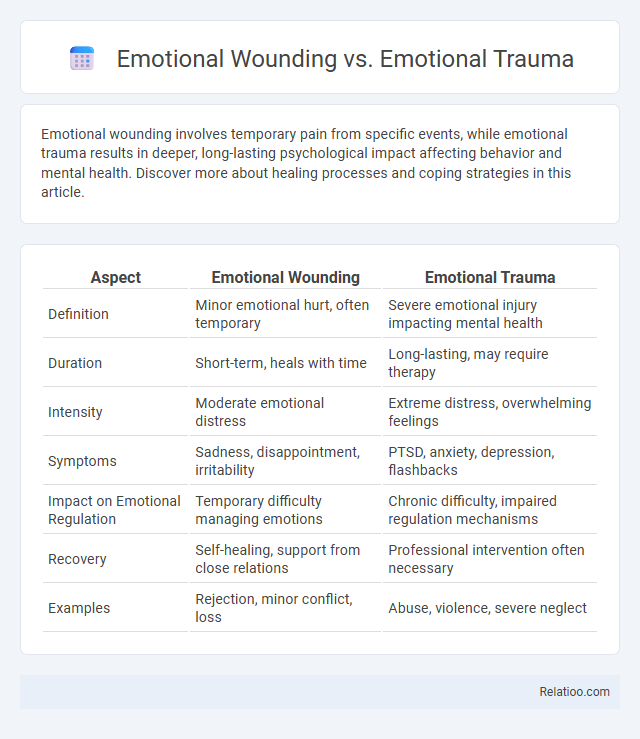Emotional wounding involves temporary pain from specific events, while emotional trauma results in deeper, long-lasting psychological impact affecting behavior and mental health. Discover more about healing processes and coping strategies in this article.
Table of Comparison
| Aspect | Emotional Wounding | Emotional Trauma |
|---|---|---|
| Definition | Minor emotional hurt, often temporary | Severe emotional injury impacting mental health |
| Duration | Short-term, heals with time | Long-lasting, may require therapy |
| Intensity | Moderate emotional distress | Extreme distress, overwhelming feelings |
| Symptoms | Sadness, disappointment, irritability | PTSD, anxiety, depression, flashbacks |
| Impact on Emotional Regulation | Temporary difficulty managing emotions | Chronic difficulty, impaired regulation mechanisms |
| Recovery | Self-healing, support from close relations | Professional intervention often necessary |
| Examples | Rejection, minor conflict, loss | Abuse, violence, severe neglect |
Understanding Emotional Wounds: Definition and Origins
Emotional wounds are deep psychological hurts resulting from specific negative experiences that impact your mental and emotional well-being. Unlike broader emotional trauma, which often involves overwhelming events causing long-term dysfunction, emotional wounds can stem from smaller, repeated incidents such as neglect or criticism. Understanding the origins of emotional wounding helps identify patterns that influence behavior and relationships, allowing targeted healing and personal growth.
Emotional Trauma Explained: Key Characteristics
Emotional trauma involves an intense psychological response to distressing events that overwhelms your ability to cope, often resulting in deep, long-lasting damage to mental and emotional well-being. Key characteristics of emotional trauma include feelings of helplessness, persistent anxiety, intrusive memories, and emotional numbness, distinguishing it from general emotional wounding, which may heal over time without significant psychological impairment. Understanding the severity and impact of emotional trauma helps in tailoring appropriate therapeutic interventions for effective recovery.
Core Differences: Emotional Wounding vs Emotional Trauma
Emotional wounding refers to psychological pain caused by specific, identifiable experiences that result in hurt feelings or emotional distress, often manageable through reflection and coping strategies. Emotional trauma involves a deeper, more intense impact triggered by overwhelming events that disrupt an individual's sense of safety and can lead to long-lasting emotional and behavioral consequences, including PTSD. The core difference lies in severity and duration: emotional wounding is usually situational and temporary, while emotional trauma produces profound, persistent effects requiring professional intervention.
Common Causes of Emotional Wounding
Emotional wounding often arises from experiences such as neglect, rejection, or betrayal in personal relationships, while emotional trauma typically involves more intense or prolonged exposure to distressing events like abuse, accidents, or loss. Common causes of emotional wounding include childhood abandonment, verbal abuse, and repeated criticism, which damage self-esteem and create lasting psychological pain. Understanding these causes helps differentiate between emotional wounding and trauma, guiding effective therapeutic approaches.
Triggers and Sources of Emotional Trauma
Emotional wounding often stems from everyday conflicts or disappointments, causing temporary distress that triggers feelings of hurt or sadness. Emotional trauma results from more intense or prolonged experiences such as abuse, neglect, or significant loss, leading to persistent psychological triggers like flashbacks or heightened anxiety. Identifying the sources of emotional trauma is crucial, as these deeply embedded wounds frequently originate from early childhood events or chronic exposure to stressors, affecting long-term mental health and emotional regulation.
Signs and Symptoms: Recognizing Emotional Damage
Emotional wounding often presents as lingering sadness or irritability, while emotional trauma typically manifests through intense anxiety, flashbacks, or numbness, indicating deeper psychological harm. Signs of emotional damage include mood swings, difficulty trusting others, and withdrawal from social interactions, which may affect Your daily functioning and relationships. Understanding these symptoms helps in distinguishing between temporary emotional wounding and more severe emotional trauma requiring professional support.
Emotional Wounds and Trauma: Impact on Mental Health
Emotional wounds and trauma both significantly impact mental health, but emotional wounds often stem from less intense, repetitive experiences that cause deep psychological scars, while trauma refers to overwhelming events that disrupt normal functioning and lead to acute stress responses. Your mental health can suffer from unresolved emotional wounds, manifesting as anxiety, depression, or difficulties in relationships, whereas trauma may result in post-traumatic stress disorder (PTSD) or severe emotional dysregulation. Understanding these distinctions is crucial for effective healing and targeted therapeutic interventions.
Healing Emotional Wounds: Effective Strategies
Healing emotional wounds requires understanding the differences between emotional wounding, trauma, and general wounding. Emotional wounding involves painful feelings from specific events, while emotional trauma refers to deeply distressing experiences that disrupt your mental well-being. Effective strategies to heal these wounds include therapy techniques like cognitive-behavioral therapy, mindfulness practices, and building a strong support system tailored to your individual needs.
Recovering from Emotional Trauma: Therapeutic Approaches
Recovering from emotional trauma involves targeted therapeutic approaches such as cognitive-behavioral therapy (CBT), eye movement desensitization and reprocessing (EMDR), and somatic experiencing, which address the deep-seated psychological and physiological impacts of trauma. Emotional wounding, often less severe, may respond well to supportive counseling and mindfulness practices that facilitate emotional regulation and resilience. Differentiating emotional trauma from wounding is crucial for selecting effective interventions that promote healing and long-term emotional well-being.
Building Emotional Resilience: Prevention and Self-Care
Emotional wounding refers to immediate psychological pain from specific incidents, while emotional trauma involves deeper, long-lasting effects that disrupt your mental and emotional well-being. Understanding these distinctions is vital for building emotional resilience through targeted prevention strategies such as mindfulness, healthy boundaries, and self-care routines like therapy and stress management. Investing in your emotional health fosters recovery and strengthens your ability to cope with future challenges effectively.

Infographic: Emotional Wounding vs Emotional Trauma
 relatioo.com
relatioo.com